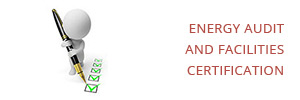Energy audit and facilities certification
Mandatory energy certification of buildings in the Republic of Croatia was introduced by Article 15 of the Law on Spatial Planning and Construction , NN 76/ 07 , 38 / 09 , 55/11 , 90/11, and is implemented through a series of basic rules and regulations applying to the obligation of 31st March 2010 for all objects defined in the Regulations on the energy certification of buildings, NN 36/2010.
Energy certification of buildings is a set of actions and procedures that are implemented in order to issue an energy certificate.
Energy certificate is a document showing the energy performance of the building.
Energy certificate contains general information about the building, building energy class, information about the person who issued the energy performance certificate, information on termotechnic systems, climate data, data on the energy of the reference and the actual climate data, explanations of technical terms and a list of applied regulations and standards.
Energy certificate for existing buildings must contain a proposal of economically viable measures to improve the energy performance of buildings based on previously conducted energy audit of the building.
Energy certificate for new buildings contains recommendations for the usage of the building in relation to the fulfillment of the essential requirements of energy saving and thermal protection and fulfillment of the energy performance of buildings.
The purpose of energy certificate
The purpose of energy certificate is to provide information to owners and users of buildings on energy performance of the building or its separate useful units and comparison of buildings in relation to their energy performance, energy efficiency of their systems, and the quality and characteristics of the building envelope.
Building energy rating
Building energy rating is an indicator of the energy performance of the building, which,for residential buildings, is expressed via the annual heat energy needed for heating, the climatic data reduced to the unit of useful floor area of the building, and for non-residential buildings over the relative value of the annual thermal energy for heating.
Residential and non-residential buildings are classified into eight energy classes according to the energy scale from A+ to G , where A+ marks the most energy efficient and G the least energy efficient class. Energy ratings are presented for climatic data.
Energy classes of residential buildings
| Energy class | Q”H,nd,ref – pecific annual energy neeed for heating for referential climatic data in kWh/(m²a) |
|---|---|
| A+ | ≤ 15 |
| A | ≤ 25 |
| B | ≤ 50 |
| C | ≤ 100 |
| D | ≤ 150 |
| E | ≤ 200 |
| F | ≤ 250 |
| G | > 250 |
Energy class for residential buildings depends on the specific annual heat energy for heating for referential climatic data in kWh/( m²a).
Energy classes of non-residential buildings
| Energy class | QH,nd,ref – specific annual energy neeed for heating for referential climatic data in kWh/( m² a) |
|---|---|
| A+ | ≤ 15 |
| A | ≤ 25 |
| B | ≤ 50 |
| C | ≤ 100 |
| D | ≤ 150 |
| E | ≤ 200 |
| F | ≤ 250 |
| G | > 250 |
Energy certificate must be included in public building or part of a mixed-use building which is, as an independent functional unit, used for a public purpose if it has a total usable area of more than 500 m², and from 9th July 2015 greater than 250 m² and any other building that is being built, sold, rented, given in leas or for rent, that is its self-contained unit that is being built or sold.
Types of buildings as a whole or separate usable building for which a certificate of energy are determined by the prevailing purpose are divided into:
A. Residential buildings:
- 1. single-apartment and apartment buildings in a row with one apartment which need one energy certificate
- 2. two or more apartment buildings and residential communities (eg. retirement homes, pupil, student, worker or children’s homes, prisons, barracks, etc. ) need one common certificate, but a separate energy certificate can be created
B.1. Non-residential buildings:
- office, administrative and other office buildings of similar purpose,
- school and university buildings, kindergartens and other educational institutions,
- hospitals and other buildings intended for health and social rehabilitation purposes,
- hotels and restaurants and similar buildings for short stays (including apartments),
- sports buildings,
- wholesale and retail trade buildings (shopping centers, buildings with shops),
- other non-residential buildings that are heated to at temperature of +18°C or higher (eg.: building of Transport and Communications, terminals, stations, buildings for transport, post , telecommunications buildings, buildings for cultural and artistic activities and entertainment, museums and libraries, etc.)
B.2. Other non-residential buildings in which energy is used to fulfill certain requirements of conditioning:
Residential and non-residential buildings are classified into eight energy classes according to the energy scale from A+ to G , where A+ marks the most energy efficient and G the least energy efficient class.
Issuing energy certificate is not required for:
- new buildings, existing buildings and useful units in new or existing buildings that are for sale, rent, lease and have usable space usage of less than 50 m²
- buildings with a planned time of use of two years or less;
- temporary buildings constructed as part of the preparatory work for the needs of the construction site
- workshops, manufacturing plants, industrial buildings and other commercial buildings which, in accordance with their use must be kept open for more than half the working time if they don’t have a built-in curtain airbags
- simple structures determined by special regulation
- existing buildings or their separate useful units that are sold or their ownership rights are being transferred in bankruptcy proceedings in the case of a forced sale or foreclosure
- existing buildings or their separate useful units that are sold or rented to a spouse or immediate family members
- buildings that are not heated or heated to a temperature of up to +12°C apart from cold storage
Regulations on energy audits of buildings and energy certification of buildings
Amendments to the Ordinance on energy audits of buildings and energy certification







